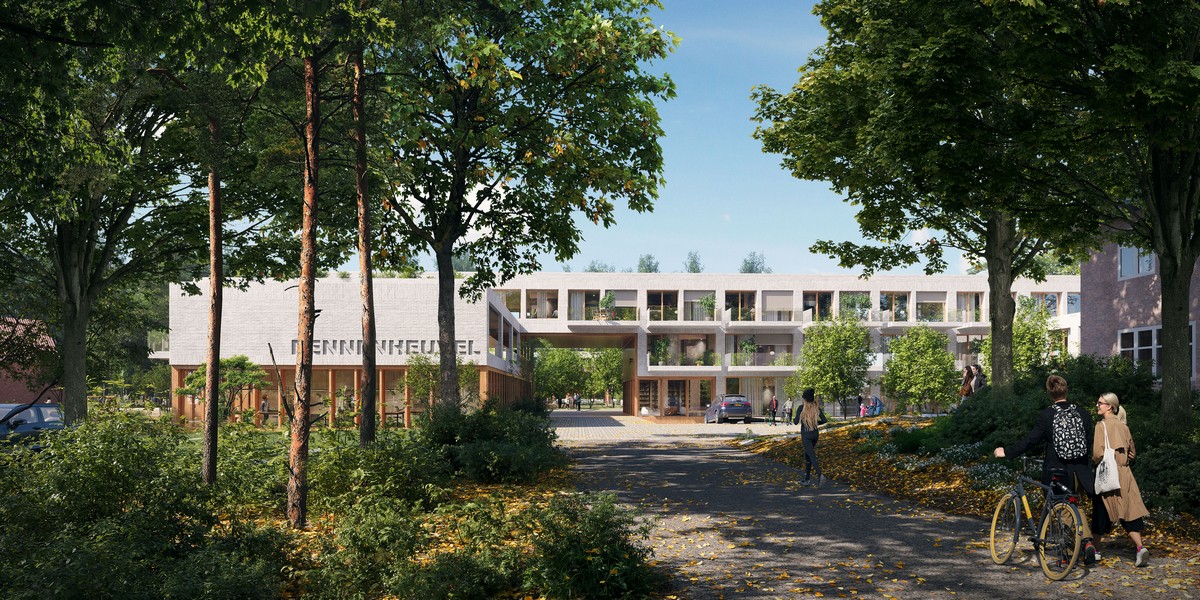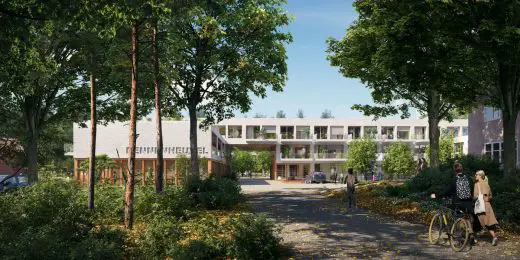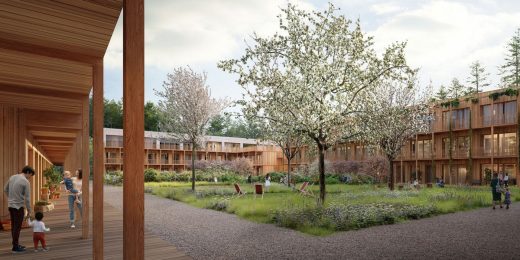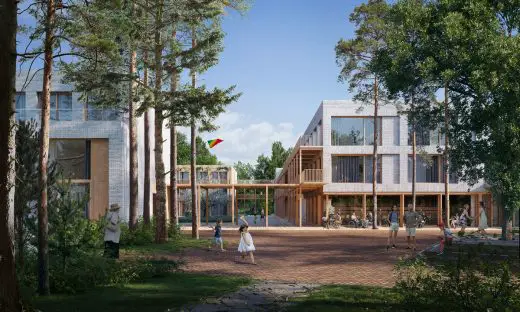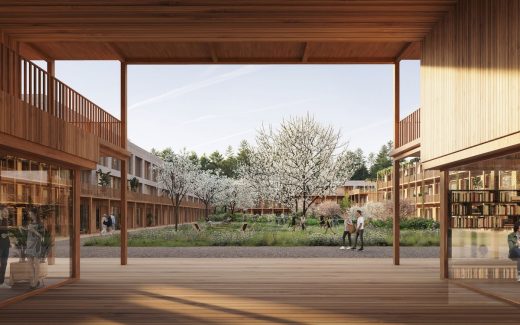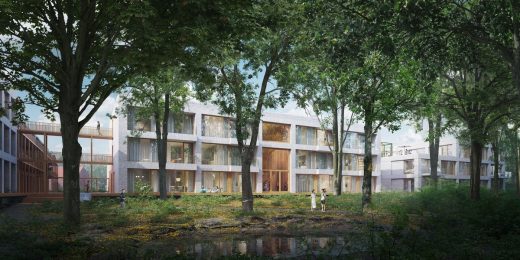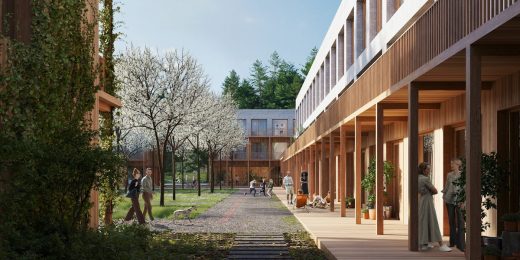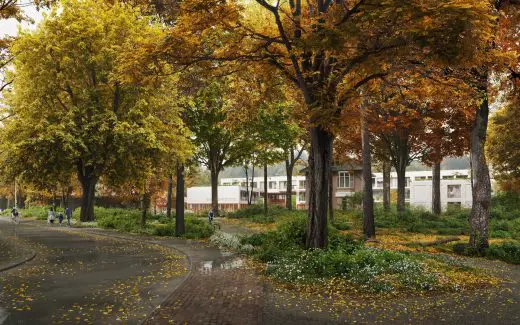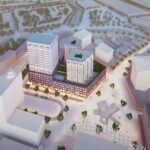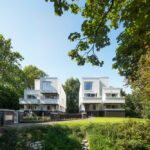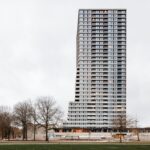Dennenheuvel Estate Housing, Bloemendaal, The Netherlands, Holland Property development, Dutch Architecture
Dennenheuvel Estate Housing, Bloemendaal, The Netherlands
18 April 2024
Design: Orange Architects and Felixx Landscape Architects & Planners
Location: Bloemendaal, The Netherlands
Renders: Vivid Vision
Dennenheuvel Estate Housing, The Netherlands
Orange Architects and Felixx Landscape Architects & Planners unveil the integral architectural and landscape sketch design to create an inclusive residential neighborhood on the Dennenheuvel Estate in Bloemendaal on the site of the former Euphrasia monastery.
Introduction
Located in Bloemendaal, between the coast and Haarlem, surrounded by dunes and forests, a new inclusive residential community with collective functions is being integrated into the local neighbourhood. The project is situated on the site of the former Euphrasia monastery and nursing home on Dennenheuvel Estate, which recently housed status holders, refugees and economically homeless people.
The new plan for Dennenheuvel includes a variety of housing types, with a mixture of subsidized rental, non-subsidized rental, owner-occupied and ground-access family homes. Moreover, a significant portion of the project is earmarked for ‘The Arkgemeenschap’, a community of people with and without intellectual disabilities who live, work and celebrate life together. In addition to the care and residential programme, the design incorporates various collective functions for the future residents of the estate, such as a living room, library, and sports and yoga facility.
Apart from providing spaces for the residents, the design features various neighbourhood amenities. These could include a pick-your-own garden and a ‘village square’ where parents can enjoy a cup of coffee while their children start a new school day.
Assignment
Euphrasia Monastery asked Orange Architects to develop an integral sketch design, based on various principles in a carefully completed participation process, for both the future buildings and their landscape integration. This sketch design serves as a basis for further elaboration of the plan.
Location
Historically, this coastal area has been served as a site for private estates and a place for leisurely walks through the surrounding dunes and forests. Traces of this historical legacy include the original tree-lined avenues and well-established forest pathways.
Dennenheuvel Estate comprises a forest near the former monastery, Villa de Terp, and an allotment garden complex on the edge of the estate. Adjacent to it are also the Sint Theresia Primary School and the St. Adelbert Catholic Cemetery, adding layers of richness to the use of the estate.
Dennenheuvel Estate holds the distinction of being part of a protected Natura 2000 area, underscoring its ecological importance and commitment to environmental preservation. The landscaping, skilfully designed by Felixx landscape architects & planners, accentuates the estate’s inherent character and recreational values. The primary goal is to seamlessly integrate new pathways with existing landscape structures.
Monastery typology
The architectural model of the monastery and its spatial organization served as inspiration for the new design. Various monastery types were studied, ranging from classical to contemporary, with a specific focus on the Euphrasia Monastery. The monastery typology consists of a group of buildings organized around a courtyard, emphasizing a strong collective component. Typically, a communal space near the entrance facilitates gatherings for both residents and visitors.
In monasteries, functions are arranged in a gradient, with more open and accessible areas in the public spaces of the building and quieter programmes in the private spaces. An architectural element essential to the classical monastery is the cloister corridor, encircling the courtyard and connecting these spaces and functions. These fundamental elements integral to classical monasteries will be translated into the new design.
Concept
The sketch design for Dennenheuvel draws inspiration from the monastery typology, interpreting it to create a communal focal point akin to the monastery garth. This large courtyard serves as a collective space, encouraging social interaction and outdoor activities among the residents. Functions surrounding the courtyard are strategically arranged, with public and collective spaces facing the street and private areas oriented towards the forest.
To facilitate connections between different buildings and programmes, a transitional space is introduced between the buildings and the courtyard. Enclosed by a wooden structure inspired by the cloister, this space serves multiple purposes, functioning as a gallery, providing balconies for residents, creating a wooden deck, or serving as a roof terrace canopy.
The landscape concept emphasizes a deliberate distinction between cultivated green spaces within the courtyards and the natural greenery outside, represented by the adjacent forest. The architectural design is sensitive to the natural surroundings, ensuring the development is not a closed-off block. Openings strategically positioned between the buildings offer residents panoramic views of the surrounding forest.
The new design introduces three main squares with distinct identities. The forecourt, more formal, serves as an entrance ‘foyer’. The second square, located between the school playground and the collective living room, is designed as a local ‘village square’. Envisioned as a dynamic area, this space encourages residents and neighbours to come together for social interaction, perhaps over a cup of coffee. The third square is a more private and contemplative space, reminiscent of a monastery garth, providing residents with a tranquil environment for relaxation and social interaction.
The architectural concept for the project draws inspiration from the serene ambiance of the white villas and estates in the countryside of the municipality of Bloemendaal. The buildings are designed to stand out like a collection of white objects nestled within the forest, creating a harmonious blend with the natural surroundings.
Programme
The plan encompasses 88 residential units, underground car and bicycle parking, and a diverse array of collective facilities. The housing programme offers a variety of typologies, with one-third allocated to the subsidized-rental sector, including 8 of the 16 units designated for the care organization ‘De Arkgemeenschap’. The remaining units comprise a mix of apartments available for rent and sale, along with single-family houses.
The majority of the apartments will benefit from daylight from two opposite sides, providing views and connections to both the collective courtyard and the beautiful forest.
The design places a significant emphasis on the social aspect, evident in the incorporation of various communal facilities. These facilities cater to a spectrum of needs, ranging from publicly accessible spaces at the front of the plot, such as a collective living room, to more private amenities tailored to the residents of Dennenheuvel. Private facilities include a library/study room and a dedicated yoga space, contributing to overall well-being.
Within the spaces between the buildings, enveloped by the wooden cloister, intimate patios emerge, each with distinctive features and characters. These small outdoor spaces serve as private sanctuaries, enhancing the overall experience of the residents. The various patios showcase diverse elements, including lush forest foliage, sandy dunes, cascading water features, and connections to the adjacent ‘village square’, each contributing to a unique and tailored ambiance.
Architecture
The architectural expression of the building facades is characterized by a sense of calm, serenity and simplicity, reflecting a cohesive family of structures with subtle individual nuances. Primary materials include white-cemented circular brick, with a simple yet detailed pattern. Wooden window frames and doors are employed to enhance the tranquillity of the facades, introducing a warm and natural element that complements the subdued tones of the white brick. This material selection contributes to a timeless and harmonious appearance.
Conversely, the facades facing the interior courtyard are clad in wood, introducing a warm and natural element. This wooden cladding not only adds comfort to the space but also accentuates the presence of the surrounding forest. The juxtaposition of the calm, white exteriors with the vibrant, wooden-clad courtyard facades creates a balanced and inviting atmosphere, enhancing the overall architectural experience.
Sustainability
In Dennenheuvel, estate with a mission, the ambitions correspond with the integral sustainability mission of Orange Architects: World We Value. Due to the special location of the project and the proximity of the Natura 2000 area, there is a high ambition to build in the most sustainable way and to carry out the project entirely in wood. Beyond the measures related to energy, materials and biodiversity, the project places particular emphasis on social aspects. Through a varied range of housing types and collective programmes, Dennenheuvel strives to allow people of different ages, social backgrounds and possibilities to live together with each other and the neighbourhood.
In addition, Dennenheuvel adds value to the context by restoring connections with surrounding estates and promoting ties with the neighbourhood. To make these connections possible, the involvement of local residents, stakeholders and interested parties in an open participation process is essential. The joint participation guarantees a maximum contribution to the mission of the collective and social redevelopment of the Dennenheuvel Estate.
Dennenheuvel Estate Housing in Bloemendaal, The Netherlands – Building Information
Design: Orange Architects – Bloemendaal and Felixx Landscape Architects & Planners – Bloemendaal
Location: Bloemendaal, Netherlands LY
Design: 2023
Size: 15.000 sqm
Plot: 7,4 ha
Program: Mixed use
Assignment: Pitch / selected
Client: Euphrasia Monastery
Architect: Orange Architects
Architecture team: Patrick Meijers, Jeroen Schipper, Julija Osipenko, Allard Meijer, Dirk Jansen,
Victoria Tomás, Dmytro Borodin
Landscape design: Felixx Landscape Architects & Planners Landscape team: Michiel Van Driessche, Natalia Andreeva, Luiz Felipe Do Nascimento, Siebe Cornelis
Visuals: Vivid Vision
Dennenheuvel Estate Housing, Bloemendaal, The Netherlands images / information received 180424
Location: Bloemendaal, Netherlands
Architecture in The Netherlands
Contemporary Dutch Architecture
Netherlands Architecture Designs – chronological list
Amsterdam Architecture Walking Tours by e-architect
Dutch Architect – design firm listings
Selection of Dutch Villas
Villa CG, Enschede
Design: Powerhouse Company
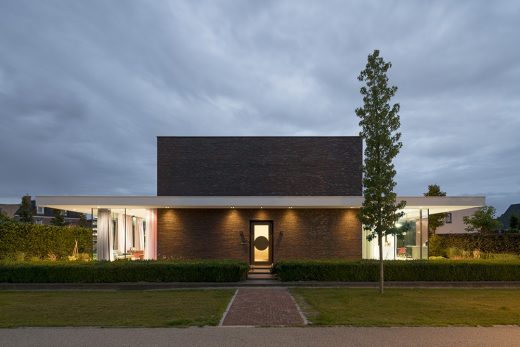
photo : Ossip van Duivenbode
Enschede Villa
Villa Berkel, Veenendaal
Architectenbureau Paul de Ruiter
Villa Berkel
Project X
René van Zuuk Architekten
Project X
Villa Röling, Kudelstaart, Aalsmeer
Architectenbureau Paul de Ruiter
Villa Röling
Comments / photos for the Dennenheuvel Estate Housing, Bloemendaal, The Netherlands designed by Orange Architects and Felixx Landscape Architects & Planners page welcome

